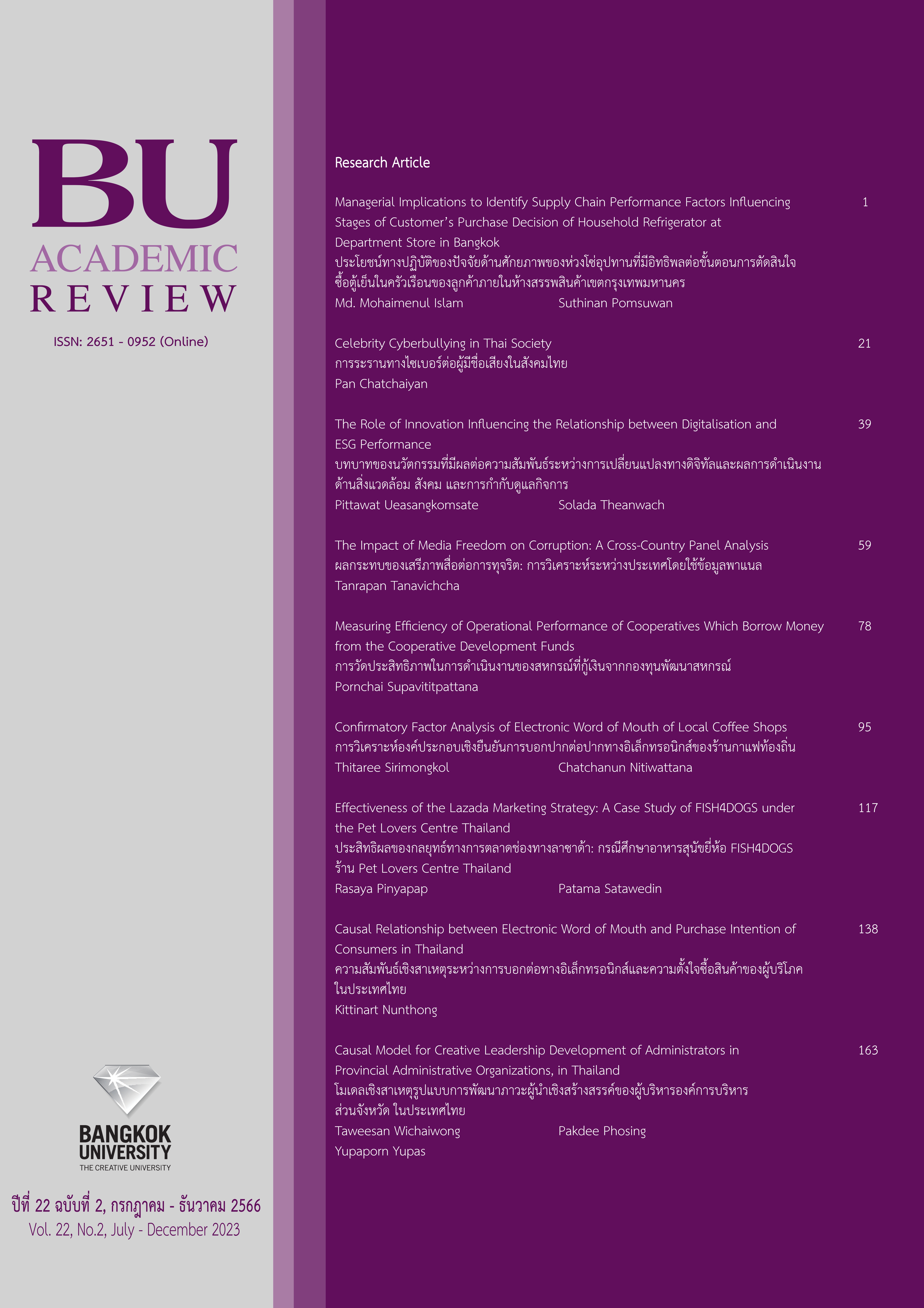โมเดลเชิงสาเหตุรูปแบบการพัฒนาภาวะผู้นำเชิงสร้างสรรค์ของ ผู้บริหารองค์การบริหารส่วนจังหวัด ในประเทศไทย
Main Article Content
บทคัดย่อ
การศึกษานี้มุ่งยืนยันโมเดลเชิงสาเหตุรูปแบบการพัฒนาภาวะผู้นำเชิงสร้างสรรค์ของผู้บริหารองค์การบริหารส่วนจังหวัด ประเทศไทย ใช้ระเบียบวิธีวิจัยปริมาณ ด้วยการตอบแบบสอบถามจากผู้บริหารองค์การบริหารส่วนจังหวัด 380 คน โดยการสุ่มกลุ่มตัวอย่างอย่างง่ายจากประชากรทั้งหมด และทำการวิเคราะห์องค์ประกอบเชิงยืนยัน ผลการศึกษาพบว่า การวิเคราะห์โมเดลเชิงสาเหตุรูปแบบพัฒนาภาวะผู้นำเชิงสร้างสรรค์ขององค์การบริหารส่วนจังหวัด สอดคล้องกลมกลืนกับข้อมูลเชิงประจักษ์ พิจารณาจากค่าดัชนีที่ใช้ตรวจสอบความตรงของโมเดล ได้แก่ = 20.13, df = 15, /df = 1.342, p-value = 0.167, CFI = 1.00, GFI = 0.99, AGFI = 0.96, RMSEA= 0.030, and SRMR = 0.017 ซึ่งโมเดลตามทฤษฎีมีความสอดคล้องกับข้อมูลเชิงประจักษ์ว่าการพัฒนาภาวะผู้นำเชิงสร้างสรรค์ ควรพิจารณาผ่าน 2 องค์ประกอบ คือ ปัจจัยภาวะผู้นำเชิงสร้างสรรค์ และความสำเร็จของภาวะผู้นำเชิงสร้างสรรค์ โดยผลการศึกษานี้สามารถสร้างข้อเสนอแนะว่าปัจจัยสำคัญในการพัฒนาภาวะผู้นำเชิงสร้างสรรค์ในองค์การบริหารส่วนจังหวัด ของประเทศไทย ต้องประกอบด้วยการมีความคิดสร้างสรรค์ และการเสริมสร้างแรงจูงใจใฝ่สัมฤทธิ์ให้กับบุคลากรในองค์กร
Article Details

อนุญาตภายใต้เงื่อนไข Creative Commons Attribution-NonCommercial-NoDerivatives 4.0 International License.
บทความที่นำมาสมัครลงตีพิมพ์ในวารสารต้องไม่เคยได้รับการตีพิมพ์เผยแพร่มาก่อน และไม่ส่งต้นฉบับบทความซ้ำซ้อนกับวารสารอื่น รวมทั้งผู้เขียนบทความต้องไม่ละเมิดหรือคัดลอกผลงานของผู้อื่น
เอกสารอ้างอิง
Ash, R. C., & Persall, J. M. (2000). The principal as chief learning officer: Developing teacher leaders. NASSP Bulletin, 84(616), 15-22.
Basadur, M. (2004). Leading other to think innovatively together: Creative leadership. The Leadership Quarterly, 15(1), 103-121.
Bennis, W. (2002). Creative leadership. Bangkok: Chulalongkorn University.
Chernin, P. (2001). Creative leadership: The strength of ideas the power of the imagination. Vital Speeches of the Day, 68(8), 245-249.
Commong, S. (2022). The factors affecting the creative leadership of school administrators under the office of Khonkhean private schools promotion commission. Journal of Buddhist Philosophy Evolved, 6(2), 518-528.
Coste, T. G. (2009). Creative leadership & women. Retrieved March 9, 2022, from http://www.pptearch.net/details-creative-leadership-amp-women-349420.html
Cronbach, L. J. (1990). Essentials of psychological testing (5th ed.). New York: Harper & Row.
Danner, S. E. (2008). Creative leadership in art education: Perspectives of an art educator (Master’s thesis, Ohio University).
Davar, R. S. (1996). Creative leadership: The people-oriented task approach. Indian Journal of Industrial Relations, 31(3), 421-424.
Guntern, G. (2004). The challenge of creative leadership. New York: Maya Angelou Press.
Hair, J. F., Black, W. C., Babin, B. J., Anderson, R. E., & Tatham, R. L. (2006). Multivariate data analysis (6th ed.). New Jersey: Person Prentice Hall.
Harris, A. (2009). Creative leadership: Developing future leaders. Management in Education, 23(1),
-11.
Jai-asa, N. (2012). Individual opinions towards the administration process in Chantaburi provincial administrative organization (Master’s thesis, Burapa University).
Kaewhan, T., & Koomkhinam, T. (2021). Creative leadership of school administrators affecting teacher competency under the secondary educational service area Nong Khai. Journal of Modern Learning Development, 6(4), 164-175.
Kelley, T., Littman, J., & Peters, T. (2001). The art of innovation (lessons in creativity from IDEO, America’s leading design firm). New York: Doubleday.
Khruathai, P., & Changrian, C. (2011). Evaluation of efficiency in public services of local administrative organizations: A case study in Utaradit and Pitsanulok. Bangkok: Office of Health Promotion Funding.
Kline, R. B. (2005). Principles and practice of structural equation modeling (2nd ed.). New York: Guilford.
Massie, J. L., & Douglas, J. (1981). Management: A contemporary introduction (3rd ed.). New Jersey: Prentice-Hall.
Meechai, C. (2021). A study of the relationships between creative leadership and effectiveness of the universities. Educational Management and Innovation Journal, 4(3), 81-98.
Nwachukwu, C. E., & Hieu, V. M. (2020). Creative leadership and creativity: An overview. In Proceedings of the 36th International Business Information Management Association (IBIMA) (pp.6680-6687). Granada, Spain: International Business Information Management Association (IBIMA).
Office of the Education Council. (2008). Educational development direction framework during the development plan National Economy and Society Issue 10 (2007-2011) Consistent with the national education plan (20022016): Summary (2nd ed.). Bangkok: Chulalongkorn University Printing House.
Parker, J. P., & Begnaud, L. G. (2004). Developing creative leadership. Portsmouth, NH: Teacher Ideas Press.
Patiphan, K. (2012). A structural equation model of creative leadership for vocational college administrators (Doctoral dissertation, Khon Kaen University).
Patiphan, K., Podaphol, C., & Seriwat, W. (2013). Creative leadership: Worthwhile trait for everyone in the future. Khon Kaen: Khlung Nanawittaya.
Pannasil, P., Phosing, P., & Kenaphoom, S. (2016). Corruption in the Thai Bureaucracy: The guidelines on prevention and solution. Journal of MCU Peace Studies, 4(2), 326-340.
Phodaphon, J. (2013). Creative leadership of sub-district municipalities administrators in Roi-ed province (Master’s thesis, Makut Rajawittaya University Lan Chang Campus).
Phongsriwat, S. (2006). Leadership: Theory and practice, sciences and arts towards perfect leaders (2nd ed.). Bangkok: Wirat Education.
Ramsiri, P., Swaengsakdi, T., & Thepsaeng, S. (2018). A development of creative leadership model of education institute administrators under local administrative organization. SWU Educational Administration Journals, 15(28), 12-25.
Samrit, N. (2015). Perceptions of functions of provincial administration organization. Local Administration Journal, 8(3), 1-9.
Theppawan, P. (2011). Strategic human resource management. Bangkok: SE-Education Public Company Limited.
Wichaiwong, T., Phosing, P., & Yupas, Y. (2021). The desired characteristics of a creative leader for developing the provincial administrative organizations. Humanities & Social Sciences, 38(1), 83-106.
Yukl, G. A. (2006). Leadership in organization (6th ed.). New Jersey: Pearson Prentice-Hall.
Zacko-Smith, J. D., Puccio, G. J., & Mance, M. (2010). Creative leadership: Welcome to the 21st century. Academic Exchange Quarterly, 14(4), 133-138.


